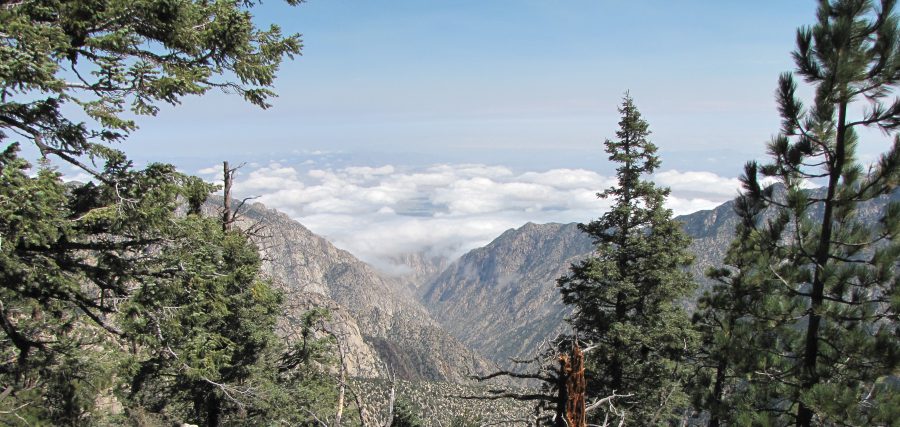By Graham Mackintosh
Northern Baja California’s Sierra de San Pedro Mártir is one of the least visited conifer forests in North America—a “sky island” surrounded by chaparral and desert.
Not only has it been protected by its own isolation, since 1947 its natural beauty has been assured through the granting of national park status in Mexico—the first location so honored in Baja California.
The park is largely comprised of meadows, rugged pine and fir capped ridges, and huge granite boulders. On the eastern edge, across the yawning chasm of Canyon Diablo, stands Picacho del Diablo (or Cerro de la Encantada) at 10,154 feet, the highest point in Baja California.
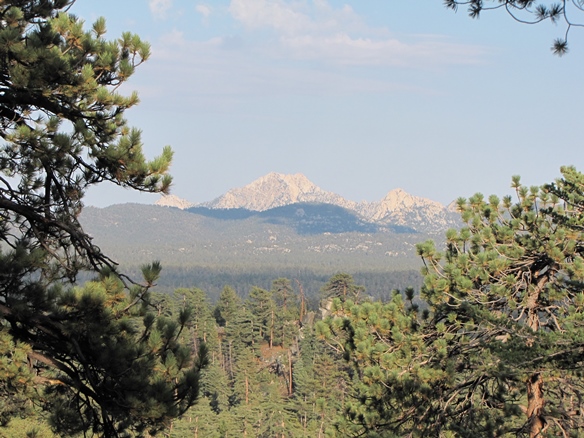 At the end of the road, Mexico’s National Astronomical Observatory stands on a ridge at 9,300 feet with spectacular views all around. Conditions are near perfect for astronomical observation with normally clear nighttime skies largely free of atmospheric and light pollution. The observatory was opened in 1975, and has several reflecting telescopes, the largest of which is 2.1 meters (83 inches). Visiting astronomers come from all over the world to enjoy the advantages of the site. Tours, centered on the largest telescope, are often given between 10:00 AM and 1:00 PM.
At the end of the road, Mexico’s National Astronomical Observatory stands on a ridge at 9,300 feet with spectacular views all around. Conditions are near perfect for astronomical observation with normally clear nighttime skies largely free of atmospheric and light pollution. The observatory was opened in 1975, and has several reflecting telescopes, the largest of which is 2.1 meters (83 inches). Visiting astronomers come from all over the world to enjoy the advantages of the site. Tours, centered on the largest telescope, are often given between 10:00 AM and 1:00 PM.
Armed with an annual pass, I have visited and camped in the park with Pili my corgi three times over the summer: in the relative calm of June, then in mid-August, and again at the beginning of September.
For many days in August, as expected, there were major storms in mid-afternoon. But nights were typically clear. It was mild, with a temperature range from 50-75 degrees F. The heavy rain was not a problem. I made sure I had Pili back in camp when clouds built to the point of precipitation. Pili tended to relax and sleep through the hail and downpour and booms in the cab… or at least as long as master was with her in the vehicle.
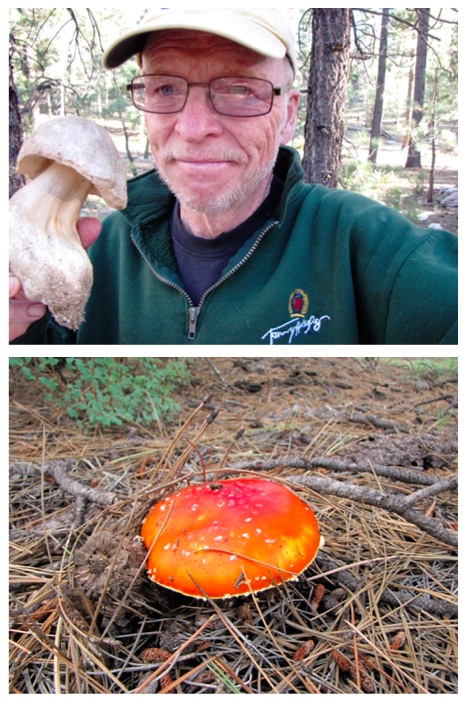 To get a fire going after the monsoonal downpours, I kept dry wood and pine needles under the vehicle.
To get a fire going after the monsoonal downpours, I kept dry wood and pine needles under the vehicle.
After 3-4 days of storms, mushrooms were abundant, including the large tasty Boletus edulis. But there were also abundant amanitas, especially the hallucinogenic and probably toxic red-capped Amanita muscaria, and several deadly poisonous amanitas.
At the beginning of September, even though Tropical Storm Lidia was threatening Southern Baja, I took Pili back to the Martir hoping we would avoid most if not all of the storm. It was hot before climbing up to the park—over 80 degrees Fahrenheit close to the coast where you leave Highway One at San Telmo, then almost 100 degrees Fahrenheit half way up at the Meling Ranch. It was mercifully cloudier and cooler approaching and entering the park, but heavy rain was soon soaking the campgrounds near the entrance.
With all the thunder flashes and booming, I decided to run across the park and camp alone at the trailhead for Picacho Diablo and Blue Bottle. There, the afternoon rain had come and gone. I put a tarp down to isolate myself from the damp ground, and then placed the tent on top… for me. Pili slept in the car.
Saturday, September 2, began far from normal. The day started windy, cool, and cloudy, with the tall pine trees bending and whipping and looking suddenly precarious. I had hoped Tropical Storm Lidia would spin off into the Pacific and not seriously impact us, but I didn’t need the radio to tell me that wasn’t going to happen. There was no rain but it was overcast and threatening all morning. I prepared for the worst. I decided to take down the tent before it was soaked. Everything normally in the tent or on the roof of the vehicle was now inside. Pili and I limited ourselves to short hikes ready to get inside at short notice.
And then it rained. Worried about the trees, I drove to an open meadow to ride out the storm. I played solitaire on my tablet, then sat and watched and worried till boredom overtook me. Concerned that I may get bogged down in the ever-softening ground, and with the wind seeming wilder in the open, I drove back to my sheltered campsite overlooking the arroyo.
That night, Lidia passed almost overhead after making its damaging way up the Baja peninsula. Inches of rain fell, mostly after 11 PM.
Fortunately, in the dark with so much rain striking the windows I couldn’t see all the big trees going through their motions… just hear the pine cones and bits of branch constantly hitting the vehicle. I slept intermittently curled up as best I could on the driver’s seat.
 Next morning, still raining, but much diminished, I stepped out and was shocked to see the dry arroyo behind us was now a major river! It ran loud and wide and was too deep and turbulent to get across. The ground was soaked. If the trees were going to fall it was going to be now!
Next morning, still raining, but much diminished, I stepped out and was shocked to see the dry arroyo behind us was now a major river! It ran loud and wide and was too deep and turbulent to get across. The ground was soaked. If the trees were going to fall it was going to be now!
The rain eased. I spent the rest of the day exploring with Pili, photographing the river, realizing that I may not see it again in my lifetime! Then I hiked to check out the road for about two kilometers. There were no major tree falls on that stretch but I was sure tree falls had happened elsewhere in the park.
Later that day, a party of rangers made it out to me in a high-clearance 4WD pickup… they informed me the park was closed, the few campers were asked to leave or move into a cabin at the entrance, and several trees were down across the highway. The rangers examined and worried about the trees that could fall onto my campsite. If I wanted to leave they would escort me out. I assured them I had plenty of everything… and it was probably safer if I stayed put for a few days.
Next day, I led Pili over three miles uphill crossing the abundant streams to stand on top of Observatory Ridge and admire the viewpoint of Picacho and the desert below. The white domes of the telescopes were visible two or three miles to the north. We were in bright sunshine, above the remnants of the clouds fast dissipating below. A brown layer was clearly visible to the north, presumably from a major fire in LA County, whereas the sky to the south was blue and clear.
 It was sunny and warm—I was glad to rest on the ridge and contemplate the scene before me. Pili was happy to bask in the warmth. I feared she was showing her ten-year-old age… certainly I had to help her over a few obstacles which the storm had cast onto the trail.
It was sunny and warm—I was glad to rest on the ridge and contemplate the scene before me. Pili was happy to bask in the warmth. I feared she was showing her ten-year-old age… certainly I had to help her over a few obstacles which the storm had cast onto the trail.
Seeing a few clouds beginning to form in the noon sky, I suspected we had reverted to the more normal late summer “monsoonal” pattern…bright blue mornings, clouds building and then rain threatening in the afternoon and clearing into the night.
It was time to get back, and we were in camp less than an hour when the senior ranger brought four forestry workers over to see the river. They assured me all was well, they had sawn up the trees across the road, and the park was open again. I broke out my last bottle of wine to celebrate.
After they’d gone, I had an unpleasant surprise… the car battery was completely flat. It was the first time ever! Looking back, it was easy to see that I’d been listening to too much radio, charging the phone and tablet, locking the doors with flashing indicators and lights, and running the fan and wipers on the short drives.
I contemplated the consequences. Certainly I couldn’t move the vehicle. And the power windows didn’t operate, but luckily one window was cracked just a quarter inch, which would let Pili breathe while she slept inside. As well as having no radio, and no ability to charge my tablet or phone, I had to lock the doors manually using the key.
Next day, realizing I may not see anyone for a week, hoping for help, I walked Pili out three miles to the road to the observatory. Clouds were building fast in the blue sky.
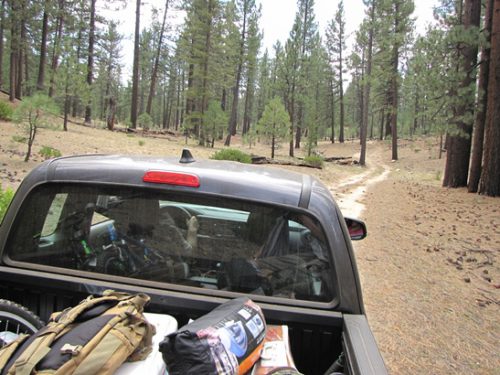 For nearly an hour, no vehicle passed. The clouds continued to build. It was now more gray than blue. I was concerned I may need to return to camp or risk getting caught out in a storm with Pili. Then a new Toyota pickup came by, heading to the observatory. The older driver and his wife kindly agreed to take me out to my vehicle and provide a jump. I traveled with Pili in the pickup bed. The Hispanic couple from Escondido were looking increasingly doubtful as we passed sawn trees and diversions.
For nearly an hour, no vehicle passed. The clouds continued to build. It was now more gray than blue. I was concerned I may need to return to camp or risk getting caught out in a storm with Pili. Then a new Toyota pickup came by, heading to the observatory. The older driver and his wife kindly agreed to take me out to my vehicle and provide a jump. I traveled with Pili in the pickup bed. The Hispanic couple from Escondido were looking increasingly doubtful as we passed sawn trees and diversions.
Bravely they drove to my hidden vehicle… jumped it and it started immediately. Thanks be… I’d imagined every negative scenario, mostly centered around squirrel-chewed cables. Then after discussion and pleasantries, they left fast as they wanted to make the observatory tour before 1 PM.
I left the engine running as I packed everything away while watching the clouds building. Then not daring to switch off the motor till close to the rangers and help, I drove non-stop to the entrance and pulled into campground Condor.
There was no one in the campground. I chose a good roomy spot with lots of tables and benches. Then I switched off the motor and only just got the tent up when there was a downpour with hail bouncing off the ground and thunder and lightning. Judging by the amount of water in the dog bowls, we had an inch of water in about an hour. Unfortunately, the inside of the tent was wet. I mopped it up with some of my laundry. As everything inside dried, at least partially, Pili and I enjoyed an evening hike in spreading sunshine. There were wonderful views of Picacho Diablo dominating the park.
Next morning, hiking around, I was startled by a large branch crashing down in the camping area, it would have nailed any camper or vehicle parked under that tree. Then we saw a nonchalant coyote a few yards away, almost pretending to be bored. It suddenly and surprisingly dashed for an endemic Mearn’s squirrel which it caught on the ground. A quick shake and it was all over; the wily coyote had scored breakfast.
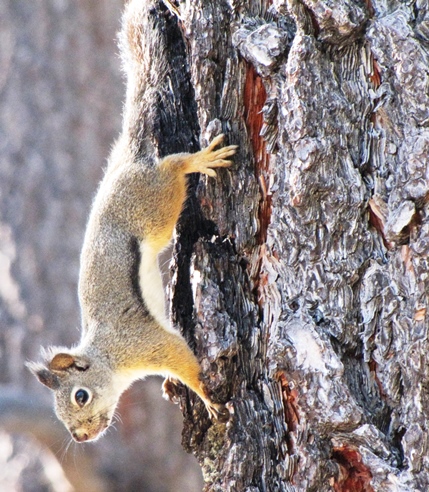 Pili had been chasing dozens of Mearn’s squirrels up trees, and smaller ground squirrels; but they simply laughed at her. The coyote showed Pili how it was done.
Pili had been chasing dozens of Mearn’s squirrels up trees, and smaller ground squirrels; but they simply laughed at her. The coyote showed Pili how it was done.
The car started with no trouble. I signed out and left the park before noon; it was clouding over and obviously going to rain. It was good to drive down, see the clouds billowing behind and be in sunshine and heat again.
And I may go back again in October. The San Pedro Martir is planning a big celebration the weekend of October 7 and 8th. It’s the 70th anniversary of the park… proudly the oldest in Baja California. The Museum will be open. There will be lectures and assorted activities. The cabins are already booked, but there should be plenty of camping. And with the road in good shape, you can make a day trip of it or stay in the warmth of Rancho Meling.
The storms will likely be over for the year, but be prepared for cold weather in the park… barring a late-season hurricane event, it should be close to freezing overnight.
For more information check the park’s Facebook page: www.facebook.com/SanPedroMartir or call their administrative offices: 011-52-646-172-3000 extension 3229.

